What are Overcurrent Protection Devices or OCPD - Electrical Faults Fixed
Table of Contents
- What does OCPD mean?
- Introduction to Overcurrent Protective Devices
- Types of Overcurrent in Electrical Systems
- Types of Overcurrent Protective Device
- OCPD Rating
- Fuses vs Trip Switches (MCB, RCBO)
- Using Fuses and Trip Switches together, Selectivity.
- What happens if we use the wrong size of fuse?
- How should an OCPD be maintained?
- Are OCPDs checked on an electrical inspection?
- Summary
1) What does OCPD mean?
OCPD in electrical terminology stands for Overcurrent Protection Device or Overcurrent Protective Device. The main purpose of an OCPD is to prevent an electrical cable from exceeding the electrical current it can safely carry according to its installation method and any installation factors that have been applied. Where there are branch circuits off a main circuit there is often a supplementary OCPD to protect that particular branch.
Where circuit conductors decrease in size, there will often be an OCPD installed at the point of reduction in size in order to reflect the smaller cable's reduction in ability to carry electrical current.
Back to top2) Introduction to Overcurrent Protective Devices
There are a few types of overcurrent protection devices that appear in electrical systems. Typically, they are the RCBO, the MCB (Miniature Circuit Breaker) and a fuse. Each of these devices is intended to protect an electrical circuit, part of a circuit or any electrical equipment from electrical overload
When current flow becomes excessive current, the OCPD is designed to interrupt the supply to the circuit or area of the circuit.
Back to top3) Types of Overcurrent in Electrical Systems
There are two types of overcurrent in an electrical circuit. There is fault current which would occur when a circuit or an appliance is in a fault condition and there is overload which occurs when current levels climb above normal levels, as would be the case with excessive appliances connected, but no fault exists.
3.1) What causes fault currents?
Common causes of fault currents are ground (earth) faults, damage to cables, Hot (Line) and Neutral touching, and equipment damage causing shorting out.
3.2) What causes overload currents?
Common causes of overload currents are excessive appliance use on a single circuit, poor circuit design, incorrect selection of OCPD.
Back to top4) Types of Overcurrent Protective Device
4.1) The Miniature Circuit Breaker (MCB)
A miniature circuit breaker offers protection against overload currents and fault currents. It manages this through two different mechanisms. When dealing with gradually increasing currents representing overload conditions, the device uses a bi-metallic strip which begins to heat up and bend away from the internal electrical contacts when excessive current flows.
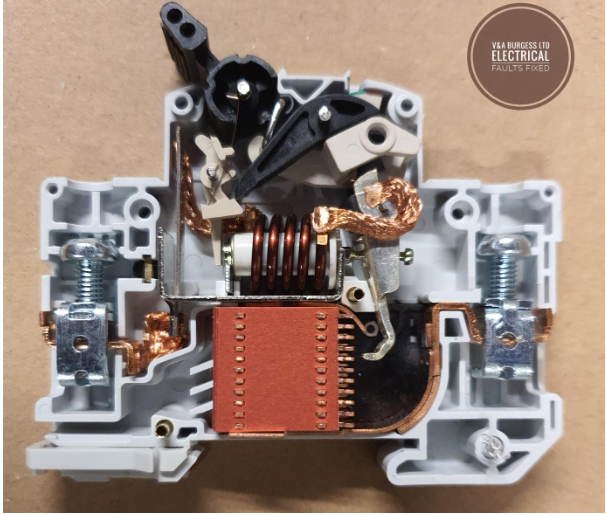
(Photo: A miniature circuit breaker cut open to expose the workings)
When the device trips through overload, it does so gradually and gently clicks off. The device will reset when it has cooled down and the form of the bi-metallic strip has returned to normal.
When the device trips through overcurrent, it uses the strength of the magnetic field created by the fault current to operate a solenoid which will turn off the circuit, usually resulting in a loud bang. This is usually as a result of an electrical fault creating a low resistance between hot (line) and earth or hot (line) and neutral. When such a fault exists, the resistance to current flow is often very low and a the electrical current that flows is inversely proportional. This means that the lower the resistance becomes the higher the electrical fault current will be.
4.2) The Cartridge Fuse
A cartridge fuse is a cylindrical device that contains a piece of metal fuse wire internally. The fuse wire is a pre-determined thickness according to the rating of the fuse. When excessive current flows through the cartridge fuse, the wire inside heats up, melts and breaks thus disconnecting the electrical circuit. The speed at which this occurs is relatively proportional to the size of the electrical current flowing through the fuse.
There is a time-current curve for each type of fuse or OCPD that tells electricians at what level of electrical current a fuse will blow and how quickly. These graphs can be found in the wiring regulations or online and can be useful when selecting the correct current rating of fuses for overload protection and any foreseeable overcurrent situation.
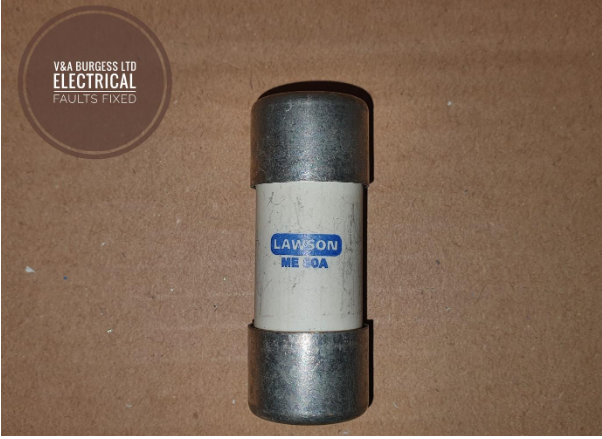
The internals are often packed with a material like sand to absorb the impact and dissipate any arcing in the event of the fuse blowing. Cartridge fuses are common in fuse boxes, mains supply cut-outs, sub mains circuits and UK appliance plug tops.
4.3) The RCBO
The RCBO or Residual Current Breaker with Overload is both an MCB and a residual current device (RCD). The device not only protects from overload and fault current but also against ground faults leading to electrical shock risk.
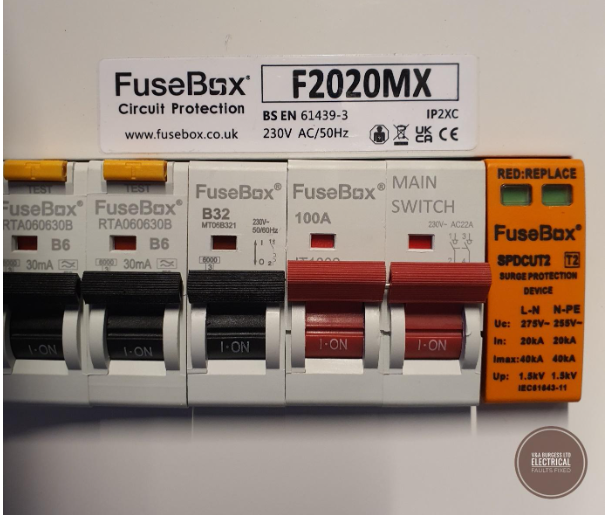
(PHOTO: RCBO devices with yellow test button for checking operation. Modern Consumer Unit)
4.4) The MCCB
The MCCB or Molded Case Circuit Breaker is a trip switch device more commonly used in commercial and industrial applications with ratings from 100A up to 3200A of electrical current.
Back to top5) OCPD Rating
The rating of an OCPD should be carefully selected in accordance with the design of the electrical circuit or size of extension cord on an appliance. Smaller diameter electrical cables will require a fuse with a lower rating in order to prevent the cables from catching fire under overload or fault conditions. Where electrical cables pass through thermal insulation, are grouped with other cables in close proximity or are subject to varying temperatures, their ability to carry electrical current efficiently will be altered.
An electrician will select the type of OCPD based upon the design of the circuit and any factors that need to be accounted for.
Back to top6) Fuses vs Trip Switches (MCB, RCBO)
Mechanical devices such as the MCB and RCBO are often preferred when protecting electrical circuits in modern wiring systems. They have some distinct advantages over fuses in that they are easy to reset and do not require replacement when they have blown once. It is also easier to examine the rating and type of a trip switch whereas a fuse will require removing to check.
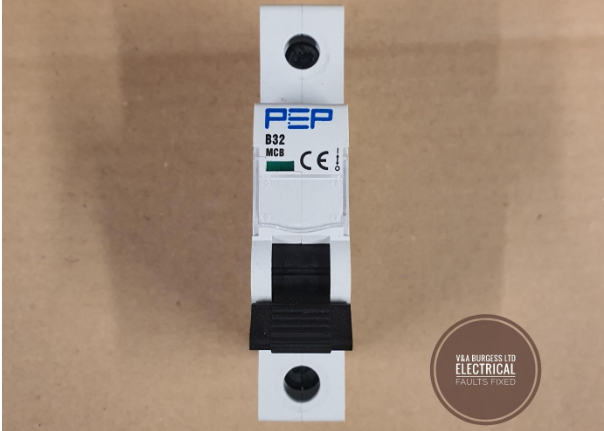
(PHOTO: The front of a Miniature Circuit Breaker)
Older Fuses in UK homes up until the early 1980s were typically BS3036 rewireable fuses. These units were relatively crude and consisted of a fuse wire carrier containing a piece of wire that could be replaced when it blew. These devices could not dispose of a very high short-circuit current and were typically able to withstand a fault current of 1-3kA.
Back to top7) Using Fuses and Trip Switches together, Selectivity.
There are many desirable circumstances when we would wish to use BOTH an MCB, RCBO, Cartridge Fuse or other OCPD together. For instance, we may have the incoming mains supply with a BS1361 fuse rated to 100 Amps, then the consumer unit contains an MCB with a rating of 32 Amps protecting a plug socket circuit, on which we have a tumble dryer appliance that contains a plug with a BS1362 fuse rated at 13 Amps. As cables decrease in size from the mains supply to the appliance, so does the fuse that protects the cable.
We would always want the fuse or OCPD nearest to the electrical fault to blow first. There is nothing to be gained by losing power to a whole electrical installation due to one faulty piece of equipment. This is selectivity working at its best and something which electricians consider in the design and installation of electrical systems.
Back to top8) What happens if we use the wrong size of fuse?
The use of overcurrent protection devices is common in appliance plug tops in the United Kingdom. If too large a fuse is used then there is a risk that an appliance cord could catch fire during a fault, if too small a fuse is used then the fuse will likely overheat continually or blow when the appliance is used.
Things become a little more serious when we consider a rewireable fuse box. Using too thick a wire in this situation could result in a house fire as cables overheat and catch fire during overload, short circuit, or other fault conditions.
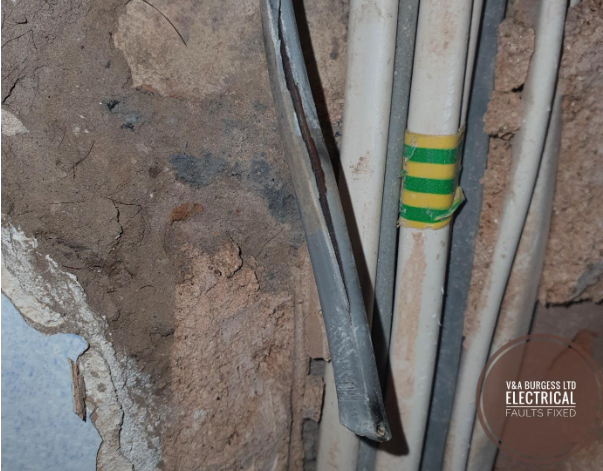
(PHOTO: Cable that has shorted out and has split from the force)
Back to top9) How should an OCPD be maintained?
Generally speaking, for fuses, the only maintenance would be checking every 6 months to a year that there were no signs of thermal damage, discolouration and ensuring that the fuse sat tightly in its holder. Where an MCB is concerned, these devices should be checked by an electrician during an electrical inspection and their operation confirmed through resistance testing along the circuit, the tightness of connection confirmed in accordance with the manufacturers torque recommendations and visual checks for any signs of overheating.
An RCBO will have a test button which should be pressed once every 6 months to ensure that the device trips when the button is pressed. If the device does not trip then an electrician should be called to replace the device. It is important to service equipment in electrical installations at the recommended intervals. A domestic property that is privately owned should be checked by a professional electrician every ten years as a general rule.
Back to top10) Are OCPDs checked on an electrical inspection?
As part of an electrical inspection the electrician will inspect the cables attaching to any OCPD along with the maximum rating of the cables to ensure that the OCPDs are correct for each cable and its installation method. The electrical panel in general will be inspected to ensure that connections are tight, equipment is in good conditions and that the basic operation of each device is as intended. Overcurrent damage to circuit breakers can result in spongy switches, switchgear failure and fire hazard. Your electrician will be able to tell you if you need to replace circuit breakers.
Back to top11) Summary
Overcurrent protective devices are a vital part of any electrical wiring system. They allow the main power source to be divided into electrical circuits so the electrical supply can be distributed around the property without the need for enormous cables. Each OCPD aims to provide fault protection for the electrical circuit it protects. Where a branch circuit is installed off a main circuit, a branch-circuit OCPD will be needed in order to protect the main circuit from overload as well as to protect the branch circuit wiring.
When an electrical engineer or electrician considers circuit design, they will ensure that they select the correct electrical devices for each circuit and its requirements. They will consider the maximum amount of current that a circuit is likely to draw and ensure that the current-carrying conductors of the circuit can cope and make sure that the rated current of the circuit breaker is correct to protect the circuit.
Back to top
Read more articles
- Log in to post comments


